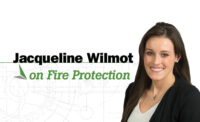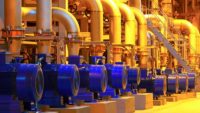Most things in real life don’t happen the way they do in the movies. Fire-sprinkler systems are no exception.
In “Die Hard,” when John McClane holds a lighter to a single sprinkler head and the entire floor floods, when James Bond charges through the airport in “Casino Royale” and a torrential downpour overflows the hallways or when Detective Riggs in “Lethal Weapon 4” pulls a fire alarm to activate the sprinkler system throughout a Chinese restaurant: These are a few examples of how the movies misrepresent the true functionality of fire-sprinkler systems. While these examples might seem clearly unrealistic, they’ve helped shape the public’s misperceptions about how fire-sprinkler systems work.
Here are some of the biggest myths that persist — debunked! Engineers should take note of these debunked myths in case their clients have inaccurate concerns about or expectations of the fire-protection system.
Myth No. 1: All sprinkler heads activate in the event of a fire
The most common misconception about any sprinkler system is that all the sprinkler heads simultaneously activate in the event of a fire. In reality, most sprinkler systems are designed so only the sprinkler head closest to the fire will activate to suppress the direct heat threat, consequently reducing water damage.
There is one specific type of sprinkler system known as a “deluge system,” which is designed to utilize all sprinkler heads simultaneously, such as the movies illustrate. These types of systems are designed to deliver large amounts of water quickly through open sprinklers (i.e., sprinklers that do not contain thermally sensitive operating elements) once a detection system activates the system. Deluge systems are installed for unique applications where a rapidly developing fire scenario exists such as aircraft hangars or certain compartments in power plants. However, this is the only type of sprinkler system designed for all heads to activate at once.
Myth No. 2: All sprinkler heads are created equal
There are several different types of sprinkler heads designed to protect specific hazards. A sprinkler head has several characteristics, including thermal sensitivity, temperature ratings, orifice size, installation orientation and water-distribution characteristics.
The thermal sensitivity measures the rapidity with which the thermal element operates as installed in a specific sprinkler or sprinkler assembly. The typical measure of thermal sensitivity is known as the Response Time Index (RTI). According to NFPA 13, Standard for Installation of Sprinkler Systems, the RTI is a measure of the sensitivity of the sprinkler’s thermal element as installed in a specific sprinkler. NFPA 13 classifies sprinklers as either fast-response sprinklers or standard-response sprinklers based on specific criteria. A fast-response sprinkler is expected to activate faster than the standard-response sprinkler in the same installation orientation. Fast-response sprinklers can be found in residential settings as well as warehouses.
The temperature rating is used to categorize the threshold of heat that will activate the sprinkler head. For example, the temperature rating of a sprinkler installed near the stove of a commercial kitchen in a hotel restaurant will have a higher temperature rating than the sprinkler head installed in its hotel rooms. This higher temperature rating for the sprinkler head near the stove in the kitchen will eliminate the sprinkler head from falsely activating from daily cooking operations.
The orifice size and shape of the sprinkler head (also known as the K-factor) determines how much water can flow through the sprinkler head as well as the size of the water droplets. The sizes range from the standard 5.6 k-factor (standard 1/2-in. orifice) to a 25.2 k-factor (2-in. orifice) installed in some warehouses for storage protection. The importance of the water droplet size comes into play when considering the possible fire scenarios in a facility. For example, if you are anticipating a fast and hot fire scenario, are the droplet sizes large enough to penetrate the plume of the fire or will they evaporate on the descent from the exceedingly high temperatures? These are the considerations fire-protection engineers take into account while determining the appropriate fire-protection system for the occupancy or commodity classification being protected.
The orientation in which sprinklers are designed to be installed also plays a critical role in the types of discharge patterns that will develop. The types of sprinkler-head orientations include concealed, flush, pendent, recessed, sidewall and upright. Concealed, flush, pendent and recessed sprinklers are all mounted to the bottom of a branch line and have similar discharge patterns. Sidewall sprinklers typically are installed in hotels or dormitories. Rather than being installed at the ceiling, they are installed along the top of a wall or lintel and are designed to discharge water outward and away from the wall instead of downward, such as with most sprinkler heads. Upright sprinkler heads are installed at the top of branch lines.
Water-distribution characteristics allow sprinklers to discharge specific spray patterns depending on the fire scenario in various occupancy types. For example, in a residential setting, furniture is typically positioned along the walls of a home. In the event of a fire, the fuel load would be along the wall. Residential sprinklers are designed to spray water on the upper walls to pre-wet the combustibles along the wall to suppress the fire. On the other hand, in an office building, where desks, filing cabinets and shelves are placed toward the center of the floor space, standard spray sprinklers utilize the downward discharge pattern to control the fire.
Myth No. 3: Sprinklers systems extinguish fires
Although sprinkler systems have extinguished an infinite number of fires since their inception in the late 19th century, sprinkler systems they have been designed to “suppress” fires by limiting the size of the fire growth and containing the fire in the area of origin. Fires are measured by the heat release rate, which is a measure of the rate at which the burning item releases energy.
Fire suppression is defined in NFPA 13 as “sharply reducing the heat release rate of a fire and preventing its regrowth by means of direct and sufficient application of water through fire plume to burning fuel surface.” If the heat-release rate from a fire is reduced by 100%, extinguishment is achieved. However, if the heat-release rate decreases between 1% and 99%, suppression can be achieved depending on the conditions of the fire scenario.
Myth No. 4: Pulling the fire alarm activates the sprinkler system
There are several scenes from action movies where someone will pull the fire alarm and the sprinkler system will discharge water. Only in specifically designed systems will the sprinkler system be connected to another fire-protection or life-safety system. Sprinklers are designed to activate when there is a significant increase in temperature at the ceiling level.
Sprinkler heads contain a thermal element, either a fusible link designed to melt when a specific temperature is reached, or a glass bulb containing liquid that will expand as the ambient temperature at the ceiling reaches a particular temperature, allowing the glass bulb to break and water to discharge. Pre-action systems are the types of systems portrayed in Hollywood, which allow water from the sprinkler piping to be released upon the operation of detection devices. This interlock between the detection system and sprinkler system allows the units to protect properties where accidental discharge of water could be detrimental, such as museums or electronic equipment areas.
Myth No. 5: All sprinkler systems contain water
There are a variety of diverse occupancy and commodity classifications that need to be protected. Determining the appropriate sprinkler systems is not a “one size fits all” approach. Think of the fire triangle: fuel, heat and oxygen. A fire only can sustain itself if it has all three components of the fire triangle. Eliminating one of these components will extinguish the fire.
Office spaces, residential occupancies and shopping malls all are examples of occupancies where a wet-pipe sprinkler system containing 100% water could be utilized to suppress a fire by removing heat.
In a commercial kitchen, adding water to a grease fire would actually make the fire worse. In this situation, a wet chemical consisting of organic or inorganic salts mixed with water to form an alkaline solution can be discharged through the sprinkler piping to extinguish the fire through a process known as saponification, which simply put, is suffocating the fire through chemical reactions.
For more information on NFPA’s sprinkler standards, visit www.nfpa.org/standards. Spread the word on these myths in the meetings regarding your systems. The right information will alleviate false concerns.
This article was originally titled “Shattering myths” in the December 2016 print edition of PM Engineer.



